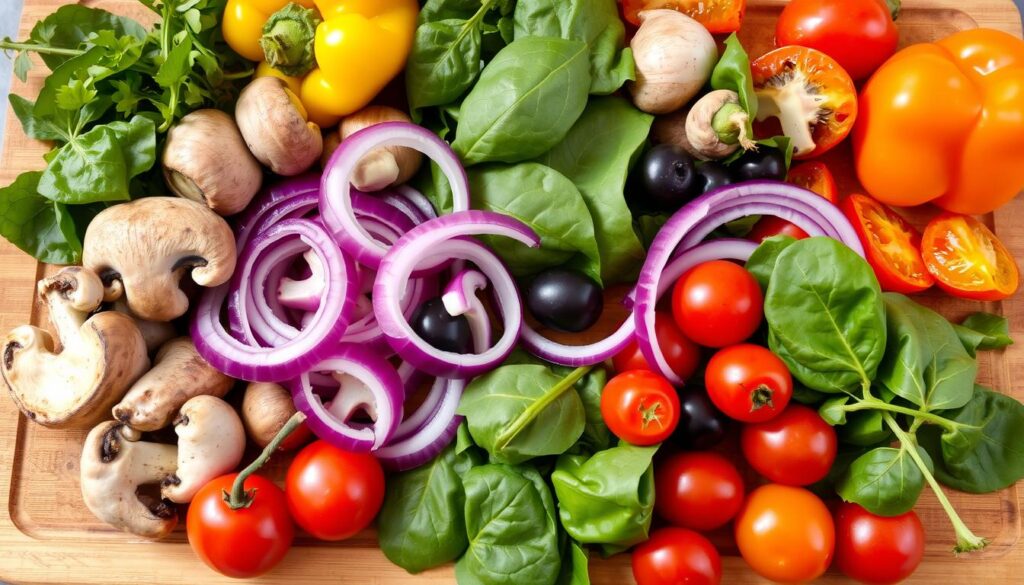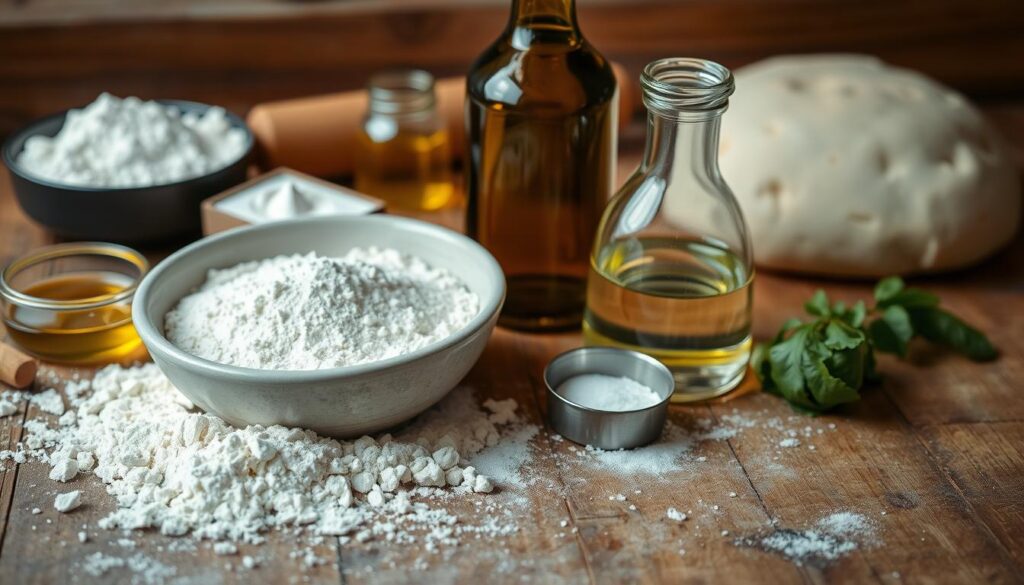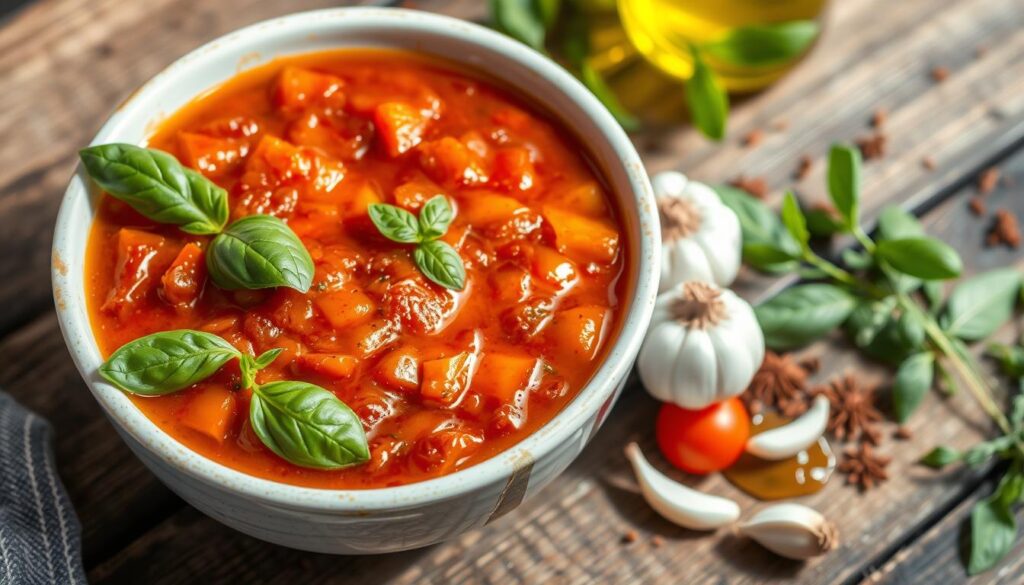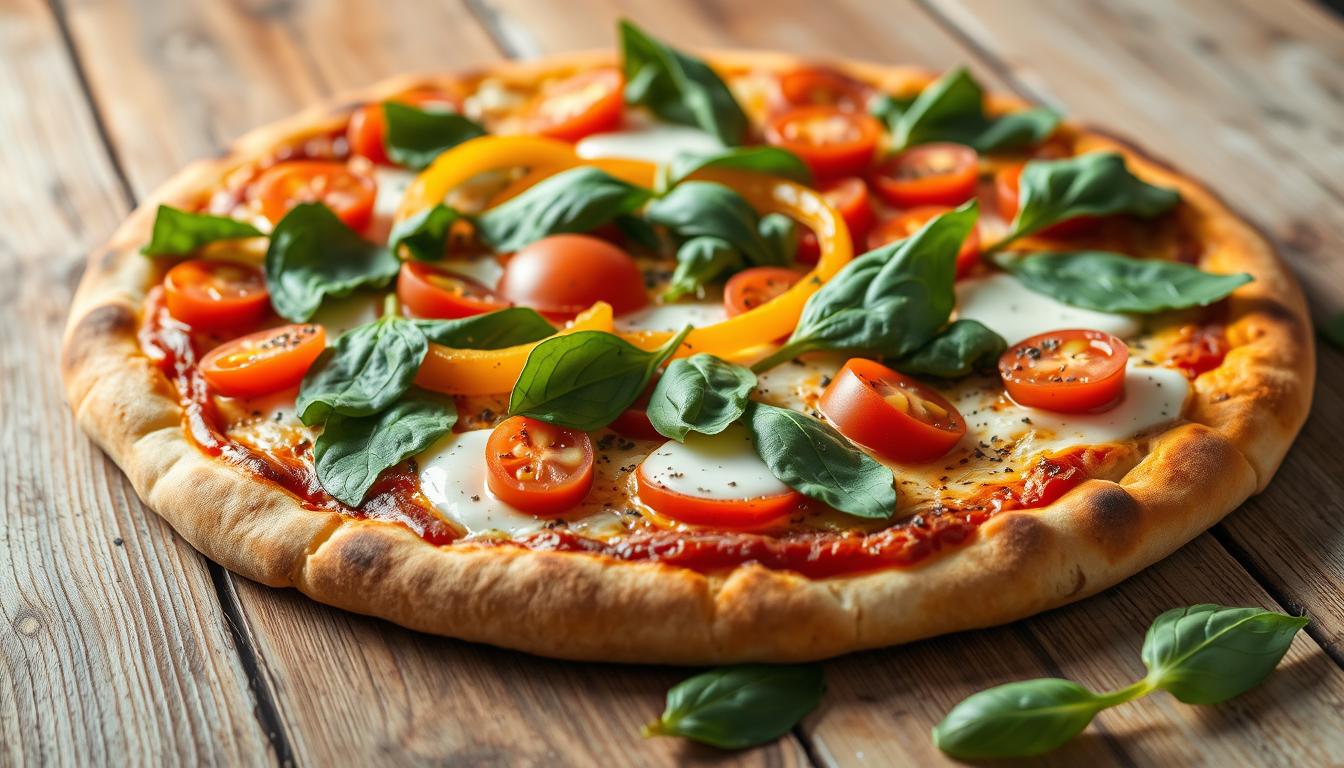Imagine making a pizza at home that tastes like it came from a restaurant. It’s both delicious and healthy. Learn how to make the best vegetarian pizza recipe that’s easy and full of flavor.
Making your own veggie pizza is incredibly satisfying. You get to pick the ingredients and toppings. This way, every bite is packed with your favorite tastes and is good for you. Are you ready to make your own amazing pizza?
Key Takeaways
- Crafting a homemade vegetarian pizza is both simple and rewarding.
- Customizing toppings allows for endless flavor combinations.
- Fresh ingredients ensure a delicious and healthy pizza.
- Homemade pizza offers a more nutritious alternative to store-bought options.
- Creating your pizza at home can be a fun and engaging activity.
Introduction to Vegetarian Pizza
Vegetarian pizza is a tasty choice for those who want to skip the meat. It’s made with fresh veggies and tasty sauces. This pizza is not just yummy but also good for you.
Benefits of Choosing Vegetarian Pizza
Choosing vegetarian pizza has many advantages. With so many veggie pizza recipes out there, you can enjoy:
- Lower calorie counts and healthier eating thanks to fresh produce
- More nutrients from vitamins and minerals in veggies
- Ethical eating options that reduce meat consumption
These benefits make vegetarian pizzas a great choice for health lovers and flavor seekers alike.
Popular Toppings for Vegetarian Pizza

Vegetarian pizzas are all about variety. You can pick from simple to exotic toppings. Here are some favorites:
| Topping | Flavor Profile | Best Combination |
|---|---|---|
| Tomatoes | Sweet and tangy | Olives, basil, mozzarella |
| Bell Peppers | Crunchy and sweet | Onions, tomatoes, feta |
| Olives | Salty and savory | Artichokes, spinach, mushrooms |
| Onions | Sharp and mildly sweet | Bell peppers, tomatoes, cheddar |
| Spinach | Earthy and fresh | Feta, garlic, sun-dried tomatoes |
These toppings not only taste great but also add color and texture. Each bite is a joy.
Essential Ingredients for the Dough
Making the perfect pizza dough is key to a great pizza. Whether you’re making a *best vegetarian pizza recipe* or trying other *healthy pizza options*, the dough matters a lot. The ingredients and how you make it affect the final pizza.

Choosing the Right Flour
Choosing the right flour is important for a good crust. For a crisp yet chewy crust, use high-protein flour like bread flour. It gives the dough the right structure. All-purpose flour makes a softer crust, great for those who like it that way.
Try mixing these flours to get the best of both worlds. This way, you get a crust that’s both crispy and chewy.
| Type of Flour | Protein Content | Ideal For |
|---|---|---|
| Bread Flour | 12-14% | Crisp and Chewy Crust |
| All-Purpose Flour | 10-12% | Tender Crust |
Perfecting the Dough Texture
Getting the dough texture right is key for a good base. Mix flour, water, and yeast, then let it hydrate. Knead the dough until it’s smooth and elastic, which takes about 10 minutes by hand or 5 with a mixer.
Let the dough rise until it doubles in size, which takes 1-2 hours. This makes the dough fluffy and ready for toppings.
Some chefs suggest refrigerating the dough for 24 hours. This makes the crust more flavorful and airy.
- Mix flour, water, and yeast.
- Knead until smooth and elastic.
- Allow dough to rise until doubled in size.
- Optional: Refrigerate for 24 hours for slow fermentation.
Crafting the Perfect Sauce
The heart of the best vegetarian pizza recipe is a rich, tasty homemade sauce. It’s key to have a sauce that ties all the toppings together. We’ll look at making the perfect homemade pizza sauce and some cool vegan alternatives.
Homemade Tomato Sauce Recipe
Start with fresh, ripe tomatoes for the best homemade tomato sauce. Here’s a simple yet flavorful recipe to boost your pizza:
- 4 cups of fresh tomatoes, chopped
- 2 tablespoons of olive oil
- 3 garlic cloves, minced
- 1 teaspoon of sugar
- Salt and pepper to taste
- 1 teaspoon of dried oregano
- 2 tablespoons of fresh basil, chopped
Heat the olive oil in a pan over medium heat. Add the minced garlic and sauté until it smells great. Add the chopped tomatoes, sugar, salt, and pepper. Let it simmer for 20 minutes until it thickens. Stir in the oregano and basil, then let it cool before spreading it on your pizza dough.

Alternative Sauce Options
Want to try something different from tomato sauce? There are many vegan pizza alternatives that can add new flavors to your pizza.
- Pesto: A vibrant green sauce made from basil, garlic, pine nuts, and olive oil. It’s a refreshing choice.
- Béchamel: A creamy white sauce made with butter, flour, and milk. It adds a rich, smooth texture.
- Creamy Cashew Sauce: Soak cashews in water, then blend with nutritional yeast, lemon juice, and garlic for a vegan-friendly creamy base.
Having different sauce options lets you meet various tastes and dietary needs. Whether you choose a classic homemade sauce or try something new, make sure your sauce is full of flavor. This will make your pizza even more delicious.
Exploring Delicious Toppings
Exploring different vegetarian pizza toppings can really boost your pizza’s flavor. Let’s look at some tasty options for both traditional and dairy-free pizzas.
Vegetables: Fresh vs. Roasted
Vegetables add freshness and nutrition to your pizza. Fresh veggies like bell peppers, mushrooms, and tomatoes bring a crisp texture and bright colors. But, roasting them can make their flavors richer and add a smoky taste.
“Roasting vegetables before adding them to your pizza can elevate your dish to a whole new level of deliciousness.”
Cheese Options for a Flavorful Pizza
Cheese is key for many pizza fans. Mozzarella and parmesan are classics, but there are also dairy-free options. Vegan cheese, made from nuts or soy, offers a creamy texture and deep flavor, perfect for those who prefer dairy-free.
By mixing fresh and roasted veggies with your favorite cheese, you can make a pizza that’s both healthy and delicious. Try out these options and find your top picks!
Assembling Your Vegetarian Pizza
Making the best vegetarian pizza starts with carefully putting together your ingredients. This ensures the flavors and textures work well together. Layering your ingredients right can turn your pizza into a true masterpiece.
Layering Techniques for Flavor
Begin by covering the pizza dough with a thick layer of sauce. Make sure it goes all the way to the edges. Use homemade tomato sauce or pesto for a unique taste. Then, sprinkle a mix of mozzarella and sharp cheese like cheddar or gouda on top.
When adding veggies, put the harder ones like bell peppers and onions first. Then add softer ones like spinach and mushrooms. This keeps the crust crispy. Use both fresh and roasted veggies for different textures and tastes.
Tips for Even Cooking
Even cooking is key for a great vegetable pizza. Pre-cook veggies like zucchini or mushrooms to cut down on moisture. Also, don’t overcrowd the toppings to let heat spread evenly.
Try different cooking temperatures and times. Start with a high heat to set the crust, then lower it to cook everything through. A pizza stone helps cook the base evenly, keeping it crispy and absorbing moisture.
Baking Your Pizza to Perfection
Baking a pizza right is key to a great crust. You need to control the oven temperature and pick the right baking surface. These steps are vital for a top-notch vegetarian pizza.
Ideal Oven Temperature
Preheat your oven to its highest setting, about 500°F (260°C). This high heat gives you a crust that’s crispy yet chewy, just like in a pizzeria. Remember, different ovens can vary, so using a thermometer is best. Getting the oven temperature right is critical, as it affects the crust, which is important for meatless pizzas.
Using a Pizza Stone vs. Baking Sheet
Choosing between a pizza stone and a baking sheet depends on what you want. A pizza stone gives you even heat, making the crust crisper. To use one, preheat it in the oven and then put your pizza on it with a pizza peel. This method is great for a traditional pizza taste.
A baking sheet is easy to find and use. It might not make your crust as crispy as a stone, but it’s good for a versatile option. Put a thin layer of olive oil on the sheet before adding your dough. Then, bake it in the hot oven for a tasty crust.
Creative Variations of Vegetarian Pizza
Exploring vegetarian pizzas opens up a world of creativity. You can mix popular styles and international flavors to make a gourmet dish.
Popular Regional Styles
Every region has its own vegetarian pizza twist. In California, pizzas are topped with fresh produce and unique combos like avocado and arugula. New York’s thin-crust pizzas feature classic margherita toppings, but plant-based.
International Influences on Vegetarian Pizza
International pizzas add excitement and flavor. Try Mediterranean with artichoke hearts, olives, and sundried tomatoes. Or, go Asian with tofu, shiitake mushrooms, and spicy hoisin sauce.
By trying different international and regional styles, you can create the perfect vegetarian pizza. It will match your taste and curiosity.
Serving Suggestions and Side Dishes
When you serve your tasty veggie pizza recipe, the right sides can make it even better. Try these options to make your meal more balanced and flavorful.
Pairing with Salads or Dips
A crisp salad is a great side. Choose a mixed greens salad with a light vinaigrette or a classic Caesar salad. These choices add freshness and nutrition to your meal.
Another good option is a variety of dips. Hummus, tzatziki, or roasted red pepper dip can boost your pizza’s flavor. Plus, they make for a fun dining experience. Serve them with crusty bread or sliced veggies for dipping!
Best Drinks to Accompany Pizza
The right drink can finish off your meal perfectly. For an Italian touch, try Chianti or Pinot Grigio. If you prefer something without alcohol, sparkling water with lemon or homemade lemonade works well.
These drinks not only refresh you but also bring out the pizza’s flavors. They make your meal even more enjoyable.
Conclusion and Final Tips
As we finish our guide to the best vegetarian pizza recipe, remember to enjoy your homemade pizzas. Storing leftovers right can keep them tasting great. Also, trying new ingredients can lead to your perfect pizza.
Storing Leftovers Properly
Keep your pizza fresh by storing leftovers in an airtight container in the fridge. For longer storage, freeze parts. Reheat in an oven or skillet to keep the crust crispy.
Encouragement to Experiment with Ingredients
Be bold with your pizza toppings and dough. Personalizing your pizza can create amazing flavors. Try different cheeses, seasonal veggies, or unique herbs and spices in your sauce.
Start your pizza-making adventure with excitement and a sense of discovery. Whether you stick to classics or try new things, making vegetarian pizza is fun and full of possibilities.

